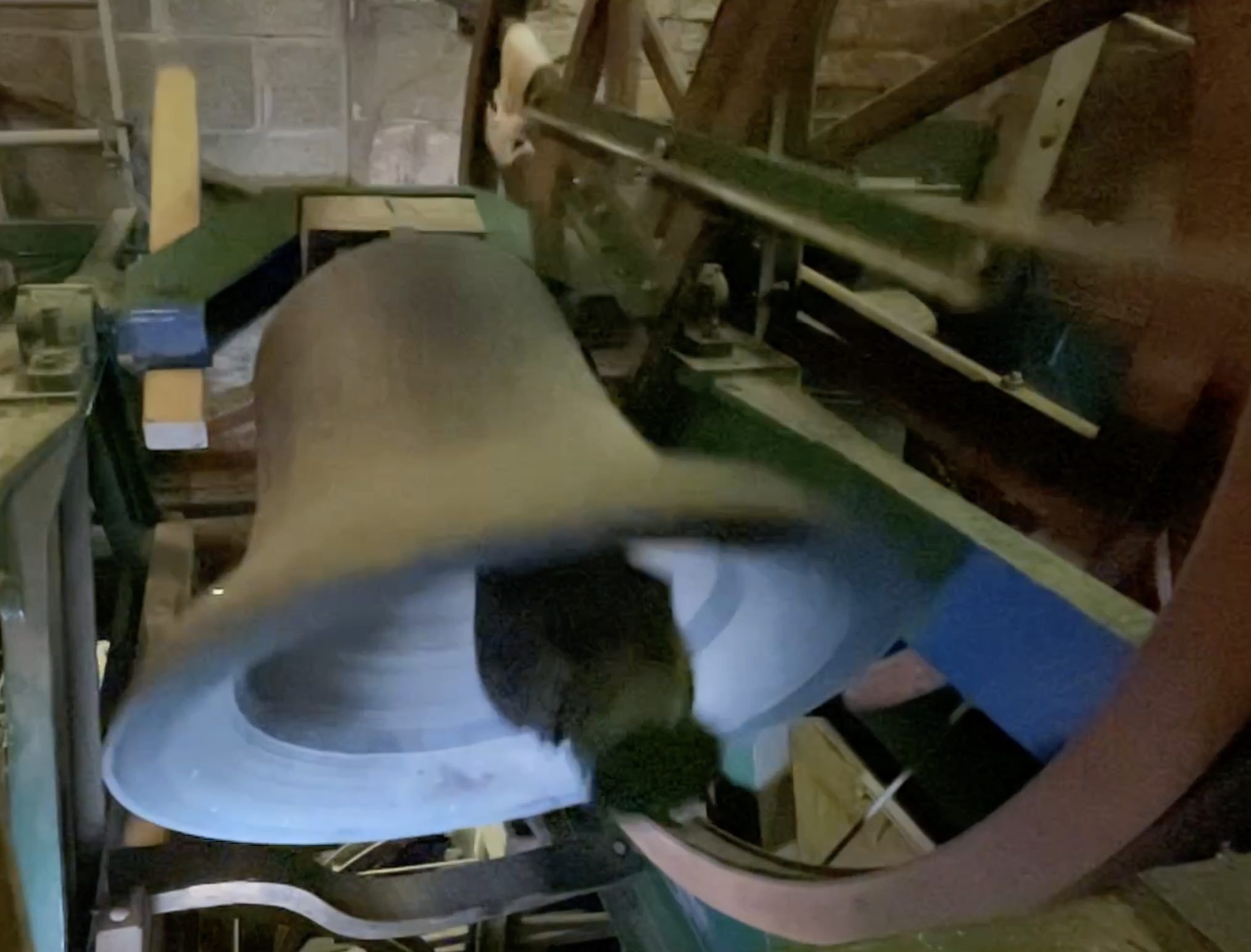
The Sound of Bells
Learn about the music and science of bells and the sounds they make.
The sound of bells is both art and science… from the frequencies and wavelengths of the sound waves a bell produces to the structure of the scales we tune the bells to, there is plenty you might want to understand better.
This article is aimed at those with a limited technical background and who want to understand a little more about how the music and science works together. It tries to explain everything in very simple terms, and a number of very complex subjects are reduced to a very basic level. If you want to find out more about bells and acoustics, this article will make a good starting point, but if you the want to build further, the websites below will take you to a much higher level… but be prepared for proper science and maths!
- The Keltek Trust has a series of article written by David Kelly for the Ringing World, which go into a lot more detail including some complex equations.
- The Sound of Bells is a Website produced by Bill Hibbert and relates to his research and PhD thesis into the world of bell acoustics… it is very interesting, but is obviously a highly academic work…
Bell Sounds
Sound is made by disturbances in the air around us. When the clapper hits the bell, it will distort the bells shape a tiny amount, causing it to get narrower and broader alternately in different places. It will wobble like a jelly!
The disturbances mean the air around it is alternately squashed or stretched as the bell moves in and out of shape. This creates ripples in the air which spread out from the bell and are picked up by the human ear.
The more the bell vibrates, the stronger the ‘ripples’. The bigger the ‘ripples’, the louder the sound.
If the ripples are closer together it makes a higher pitched sound. Those which are further apart have a lower pitch.
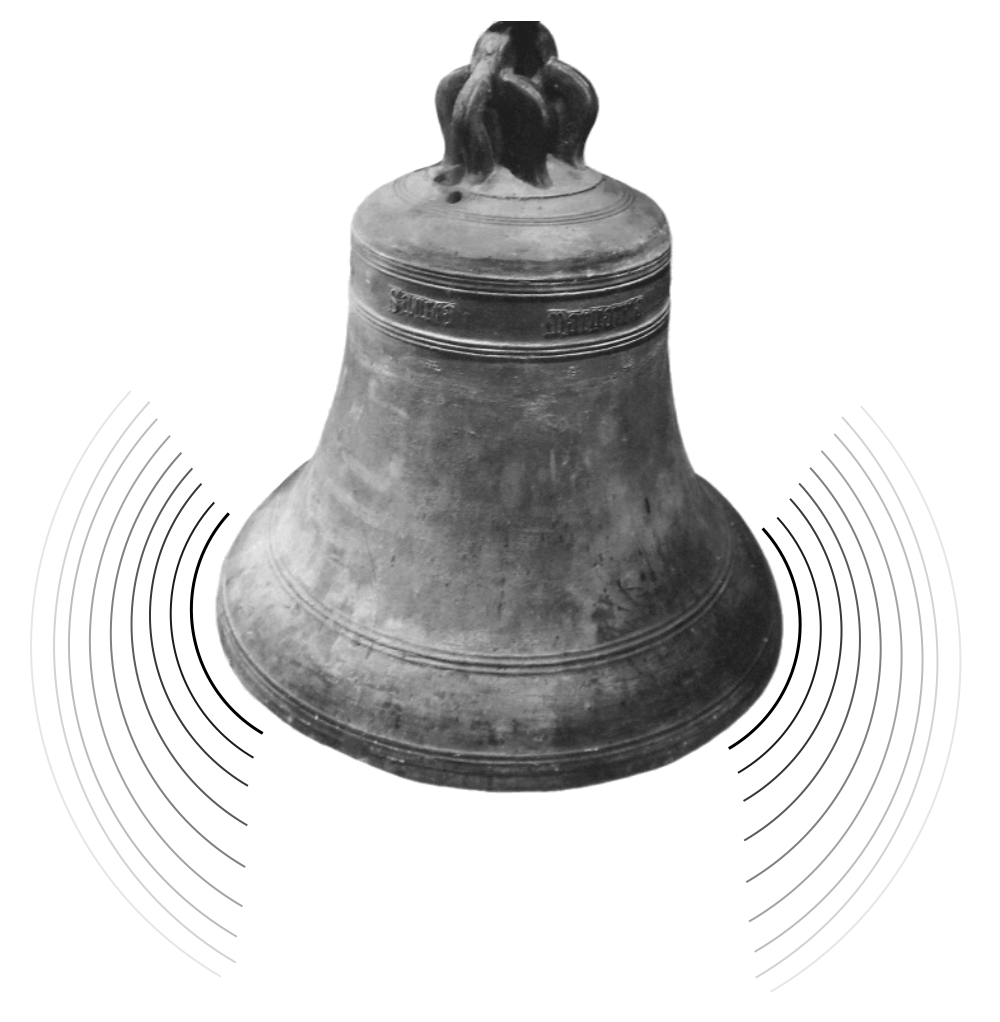
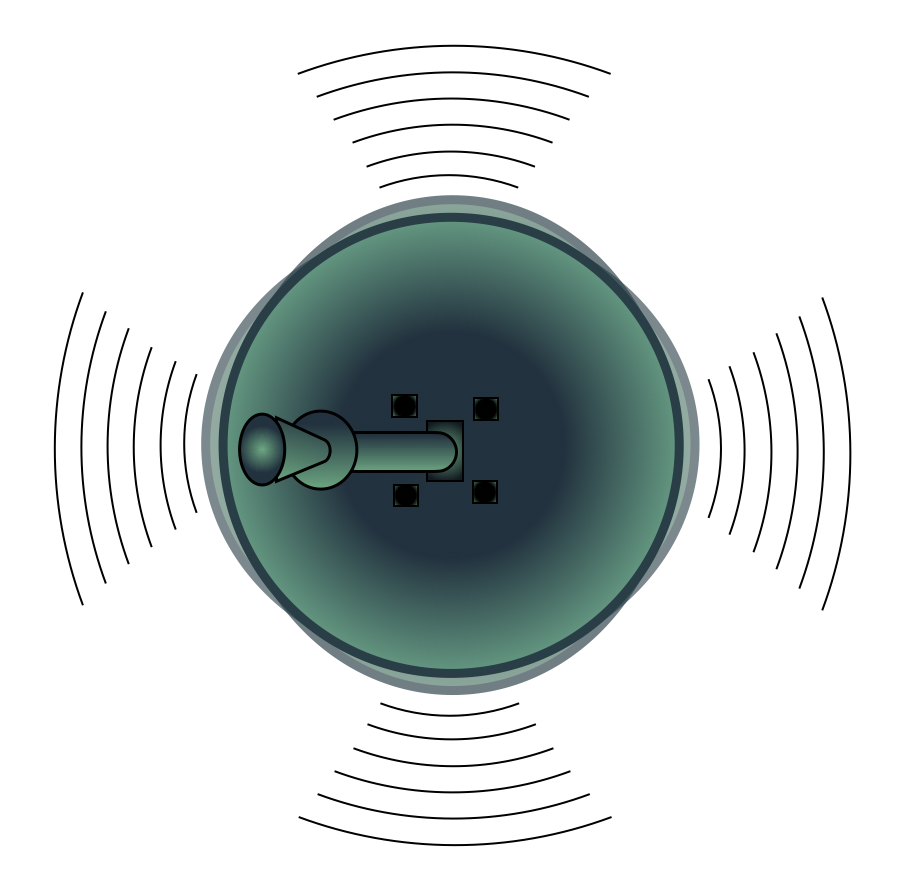
Distribution of Sound
The bell will alternately get a tiny bit narrower and wider, as it vibrates.
The resultant changes in air pressure as it is squashed or stretched by the bells movement will then radiate outwards… just like ripples on a pond. Like the water at the top of a ripple that is raised, higher air pressure will flow to a lower pressure space and the air that is at lower pressure will suck nearby air back in. This movement in turn moves your ear drum and is the sound we hear.
This all happens at a speed which matches the medium…
Because water is quite thick, ripples move quite slowly… but air is much thinner, so everything is much, much quicker…
This speed, will be familiar… It is the speed of sound!
The Speed of Sound
The speed of sound is fast… We know Concorde was about the only airliner to to go any faster… and it was pretty special!
- The speed of sound is 340 meters per second… (or 1000ft per second in ‘old money’…
Although this is fast, it is still a million times slower than light and the difference is easily discernible by us with eyes and ears.
Lightning and Thunder is probably the best example of this… We count the delay between the light and sound to work out how far away the strike was. 5 seconds per mile. But even fireworks which are only tens of meters away will show a noticeable delay between the ‘flash’ and the ‘bang’!

Measuring Sound
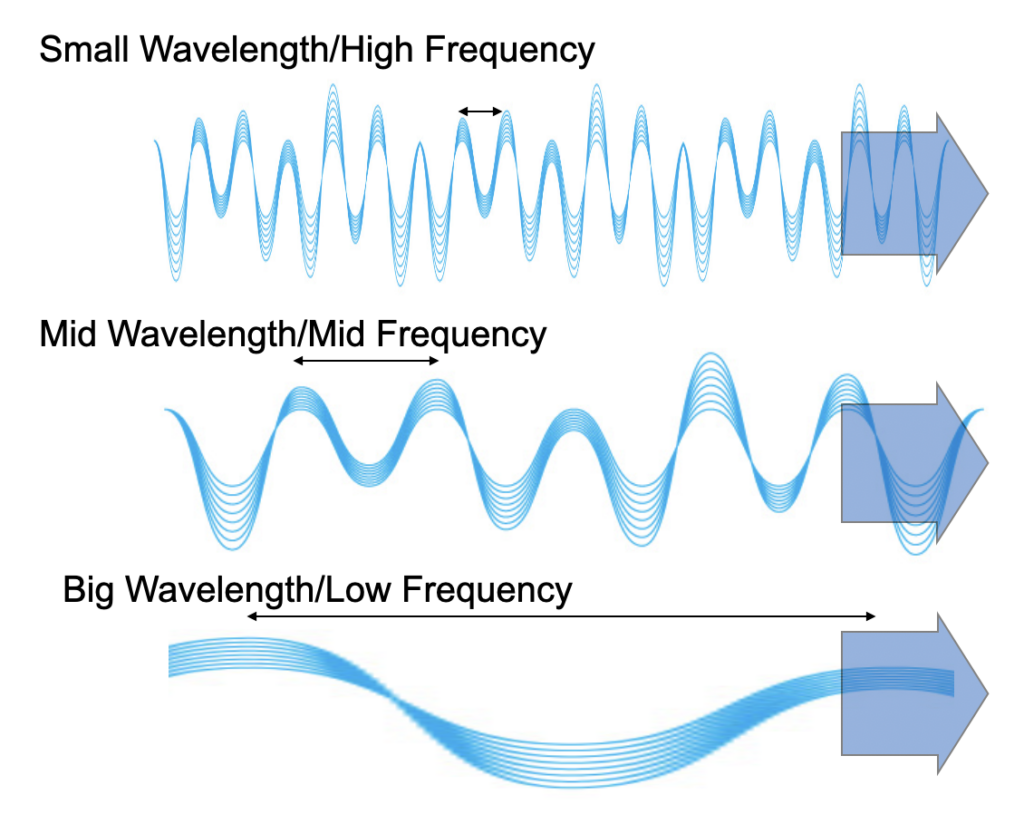
Frequency and Wavelength
Pitch is the musical term for frequency… Frequency is about how many ripples are passing each second…
If all ripples spread out at a constant speed (the speed of sound!) then in a fixed period, the closer together they are, the more of them there must be.
The distance between these sound waves is called wavelength and it gets smaller as pitch (frequency) increases and longer as pitch (frequency) decreases.
Octaves
Musicians measure pitch in octaves. An octave is a group of 8 notes which start and end on the same note letter (e.g. C,D,E,F,G,A,B,C).
Notes with the same letter sound similar, because they have frequencies which align almost perfectly… This will be double/quarter or two/four time etc., the value of their namesakes.
So in a ring of eight bells… both 1 and 8 will have the same note letter, but the frequency of the treble will be double that of the tenor and the wavelength will be half the distance.
If the Tenor frequency was 680Hz the Treble will be double – 1360Hz…. i.e. 1 octave higher. Equally, the tenor wavelength will be 0.5m and the trebles will be 0.25m.
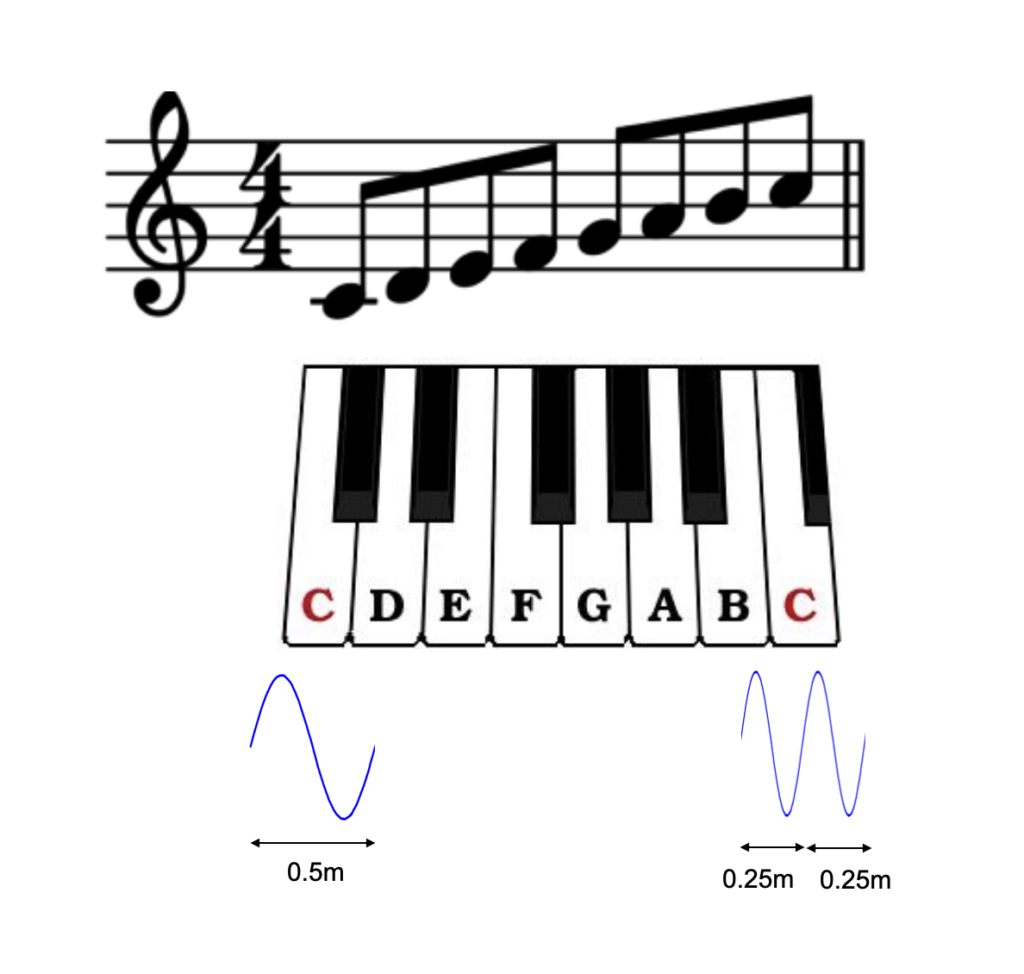
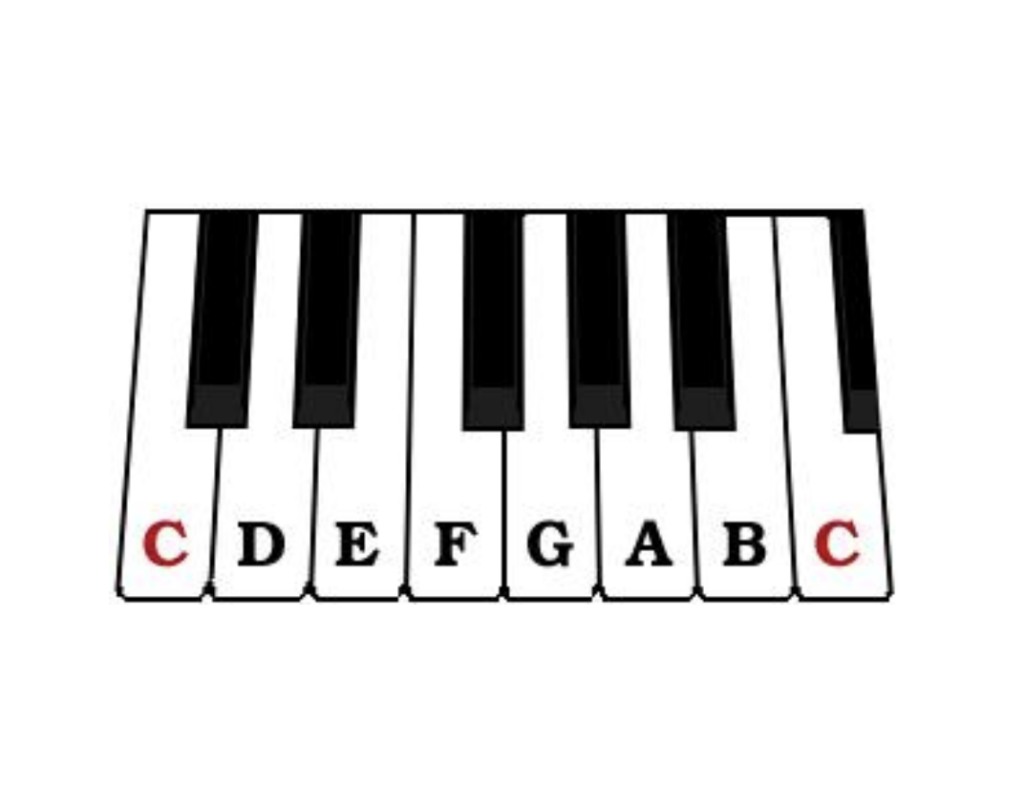
Notes
If we look at a keyboard, we will see that as well 7 different white notes, there are also 5 black notes. A total of 12 notes before a pattern repeat occurs.
Each black note falls half way between the two white notes it bisects… The gap between every note is the same… 1/12th octave… but as not all white notes have a black note to bisect them, the gap between white notes varies…
In music, the gap between the majority of white notes is called ‘a tone’. It is 1/6th of an octave. So the gap between a white and black note is half that… a semi-tone’. The gaps between E-F and B-C are also a semi-tone as there is no black note.
Sharps and Flats
Just to confuse things…. every note has multiple different names.This is because the musical notation system dates back to medieval times when life and music was simpler… and long before we understood things the way we do now.
A note a semi-tone higher can be denoted by the same letter plus a ‘sharp’ (#) and a note a semi-tone lower by a ‘flat’ (♭).
So the first black note in the diagram is both C# and D♭.
….Because of the missing black notes, F is also E# and E is also F♭!
The reason for this is continuity when creating scales… We do not want the same letter appearing twice in the same scale… e.g F and F#.
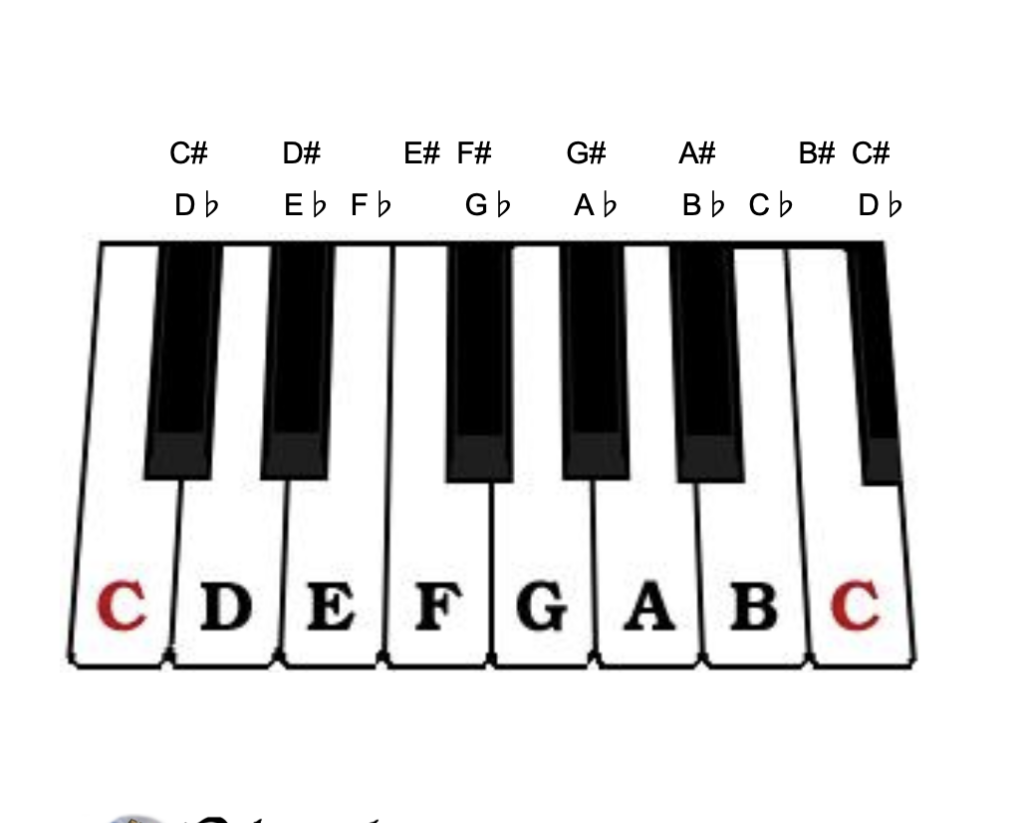
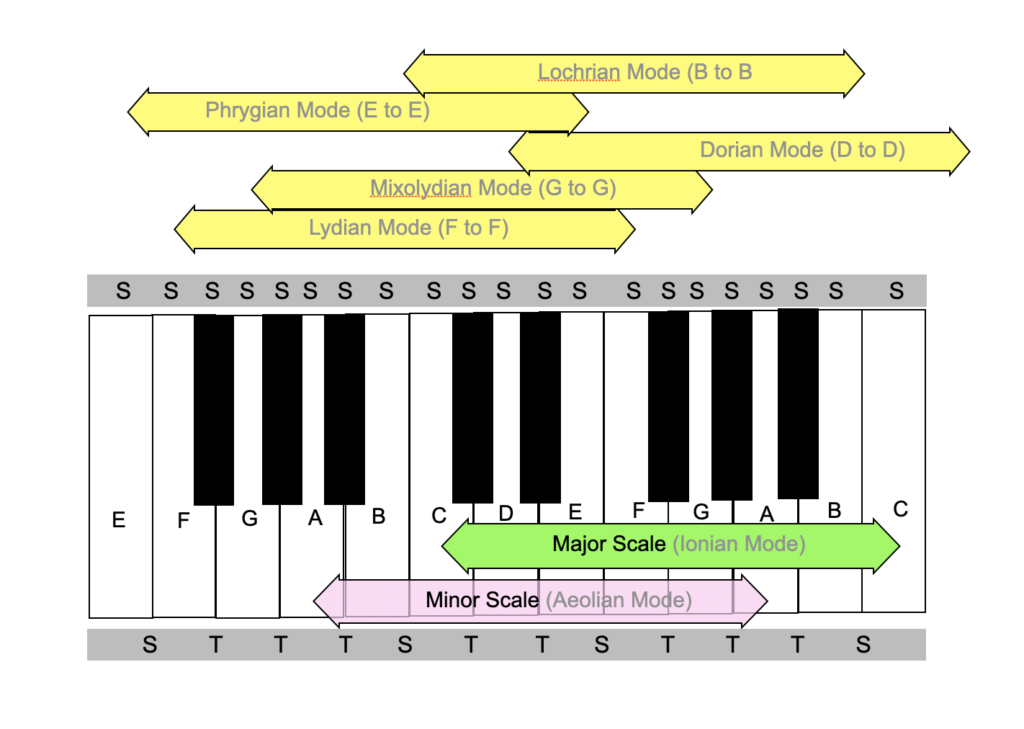
Scales
If we play a sequence of 8 white notes, we can create a scale… Where we start will change the sound because it will alter the sequence of tones (T) and semi tones (S).
In western culture, we mostly use 2 scales….
- A major scale is made by T T S T T T S and can be made using only white notes by starting on C.
- A minor scale is quite complicated, but a simplified version is T S T T S T T. This can be made with white notes starting on A.
There are many other scales using just white notes… and a lot more too that don’t. These other scales are common in folk, early and world music and are often referred to as ‘modes’.
Keys
Most rings of bells use a major scale… (T T S T T T S).
It is possible to create that pattern starting on any note. The lowest note (the tenor in bell ringing) denotes the key.
At Pebworth, our tenor is an F#, so the key is F# major. This then prescribes all the other notes…
- The 9th bell will be one tone higher at G# and the 8th another whole tone, A#.
- The 7th will be up a semitone, B… followed by three more tones. C#, D#, E# (which is actually the same as F!)
- Then we get to 3, 2 and 1 which reaches the next octave, so F#, G#, A#.
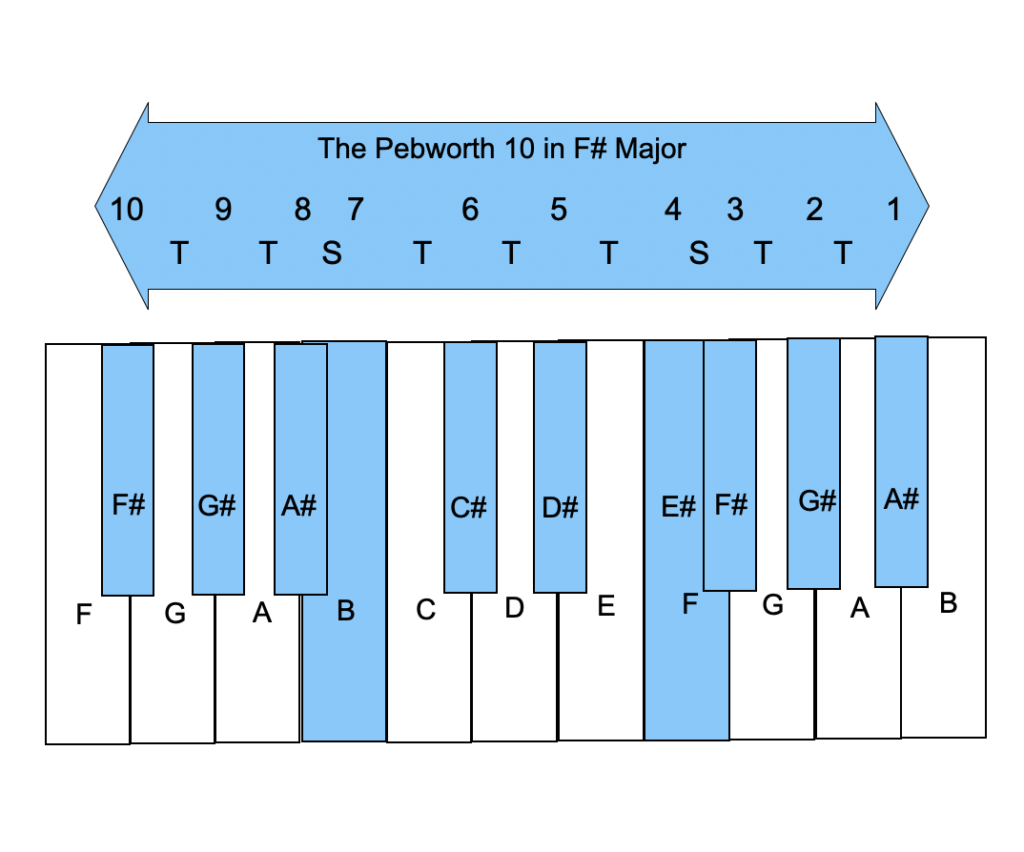
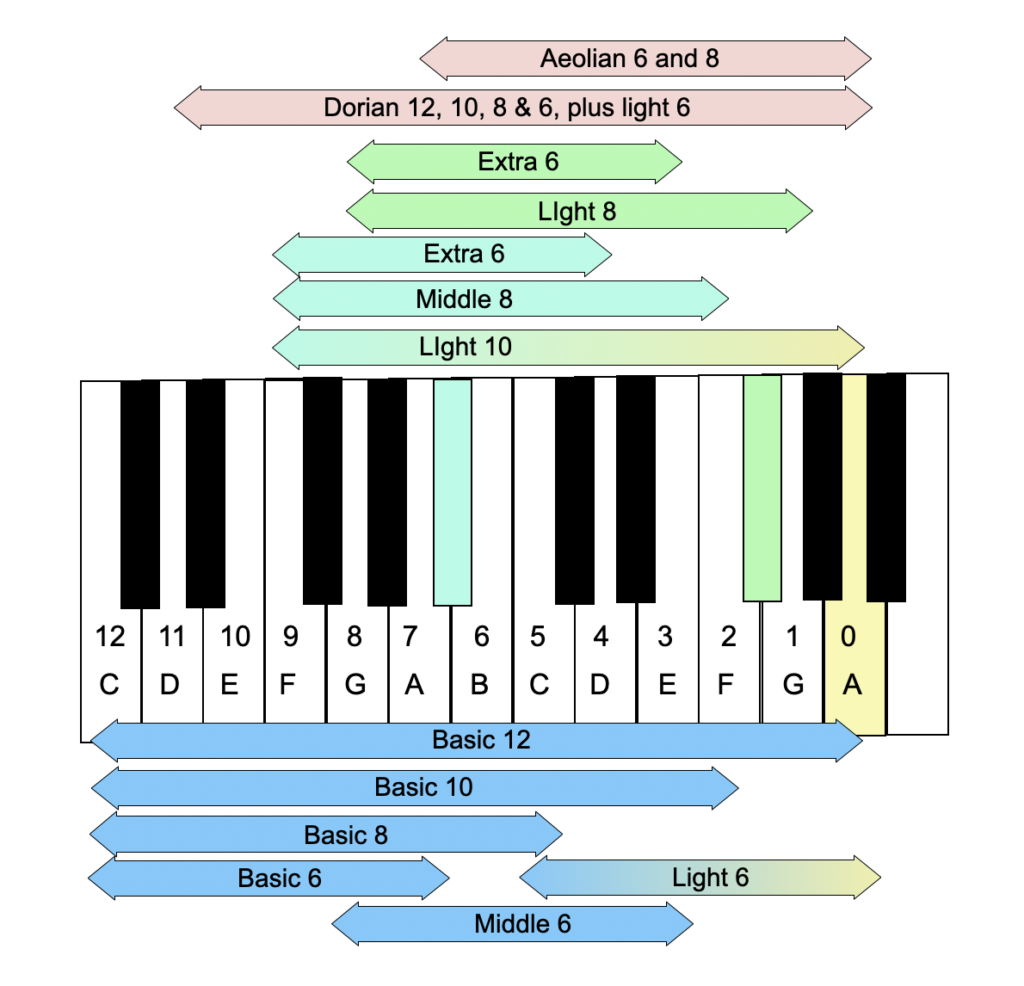
Extra Bells
Some large 12-bell towers have extra bells… Common options include a flat 6th or sharp 2nd and an extra treble (bell 0!).
These additional bells allow extra major scales to be used… and therefore alternative rings of bells.
Of course, any tower can ring alternative sets… it is just that most will not be a major scale… but some of the modes…. Dorian and Aeolian are common to English folk song, so will probably sound quite pleasant to the ear… although very different from the usual major scale.
In the diagram, you can see how adding these extra bells provides 18 different possible variants… 11 of which are standard major scales!
Frequency v Wavelength
The speed of sound in air is constant at all frequencies.
Frequency x wavelength always equals the speed of sound…. i.e. 340 meters per second. So as frequency increases, wavelength has to decrease.
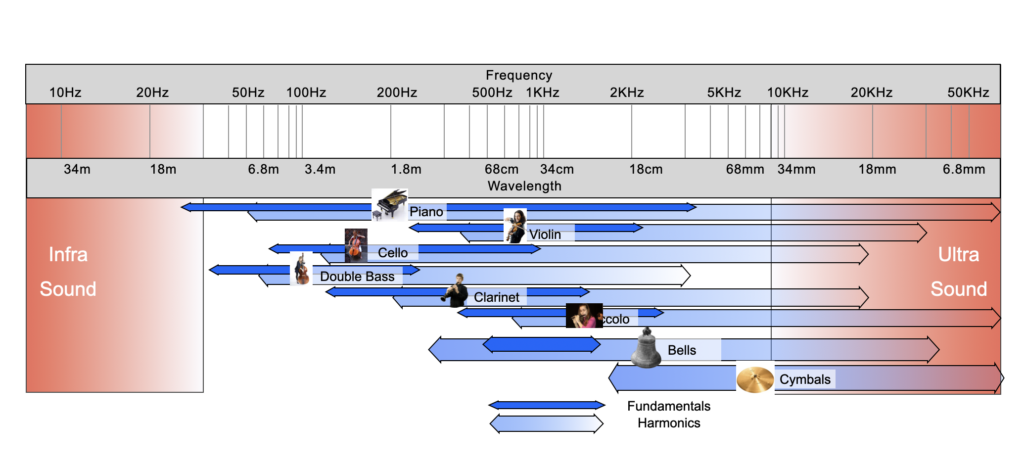
In the diagram, you can see not only the frequency and wavelength, but a variety of musical instruments and the notes they can play, shown by the darker arrows… The lighter arrows, show the harmonics… the frequencies which give the instruments their own specific character.
Infra sound is the area, where the pitch is too low for us to hear… This is the kind of sound you will feel and which might cause Aunties vase to fall off the shelf and smash!
Ultra sound is the sounds that are too high for us to hear… This is sound for bats and pregnancy scans!
Frequency v Pitch
An Octave is when the pattern on a keyboard repeats and is a doubling of frequency.
An Orchestra tunes to A = 440Hz…. so the next octave up is at 880Hz and down is at 220Hz.
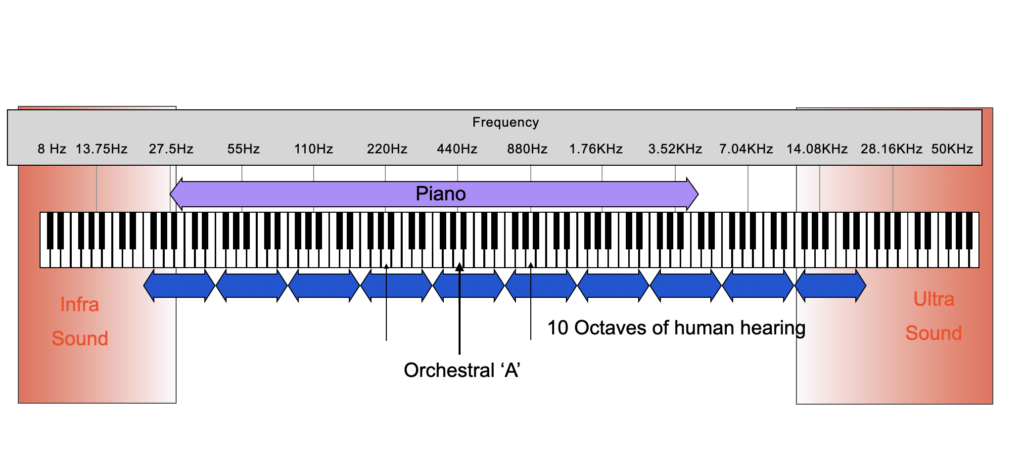
The giant piano keyboard shows 13 octaves… nearly double that of a real piano. It equates to everything from about 8Hz – 50,000Hz… an enormous range! The 10 blue arrows show the notes we can actually hear, although it is likely that as you get older the highest octave (at least) will disappear. Elephants and whales will be able to hear to the very lowest notes, while very small animals will be able to hear a good way into the highest ranges.
Sound Quality or Tone
Good Vibrations...
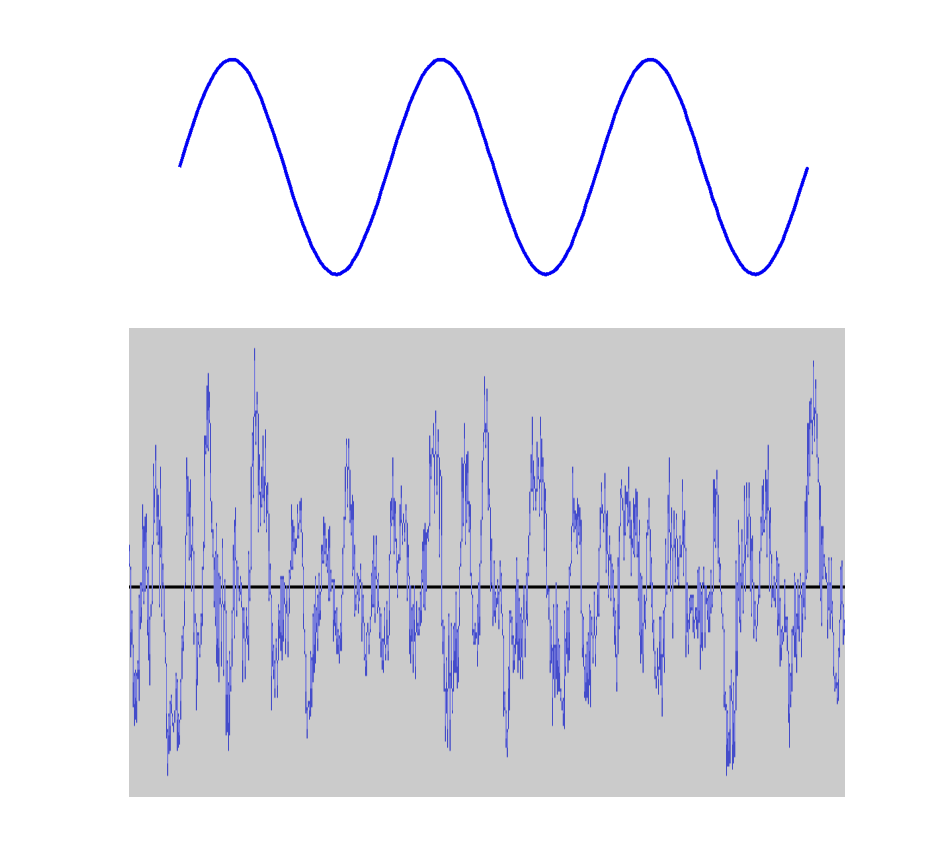
We all have favourite rings of bells… glorious sounding, smooth and tuneful…
….and then there are those that get described as ‘buckets’, ‘pans’ or ‘old pots’.
So what is the difference?
The vibrations produced by real objects are always very complex. It is only test tone which has a pure simple curved shaped.
Electronic test tones are sine waves made from a single frequency. Real sounds have many different parts to their waveform or shape. This is what gives a sound its ‘quality’, ‘timbre’ or ‘tone’.
An engineer can analyse a complex wave into different parts, called harmonics. This takes everything back to sine waves. Each sine wave will have its own loudness and frequency and there will be plenty… So real sounds are made up from lots of different frequencies (notes) mixed together.
Harmonics
In the diagram below you can see a number of different frequency sine waves in the pale red boxes. Each box is the same size to make it easy to judge the frequency. The first box has 1 complete sine wave and it is normally the pitch we hear as the note in question…. The next has three sine waves and the third has five. We call these the 3rd and 5th harmonics and they are 3x and 5x the frequency of the fundamental.
In the lilac boxes below, you can see what happens when you add the upper boxers together… It shows the shape of the sound reaching your ear.

In the simple example above…. you will see that as we add the odd harmonics together the resultant shape gets more and more square.
Inside your ear, the cochlea (which is behind your ear drum) will be able to reverse engineer the wave that arrives and extract all the individual sine waves. You brain is sent this information and from it, you will recognise the particular sound from its complex signature of harmonics.. The maths required to do this is very complex and is called fourier analysis… but your ear can do it in real time and with out you even having to think… which is quite amazing!
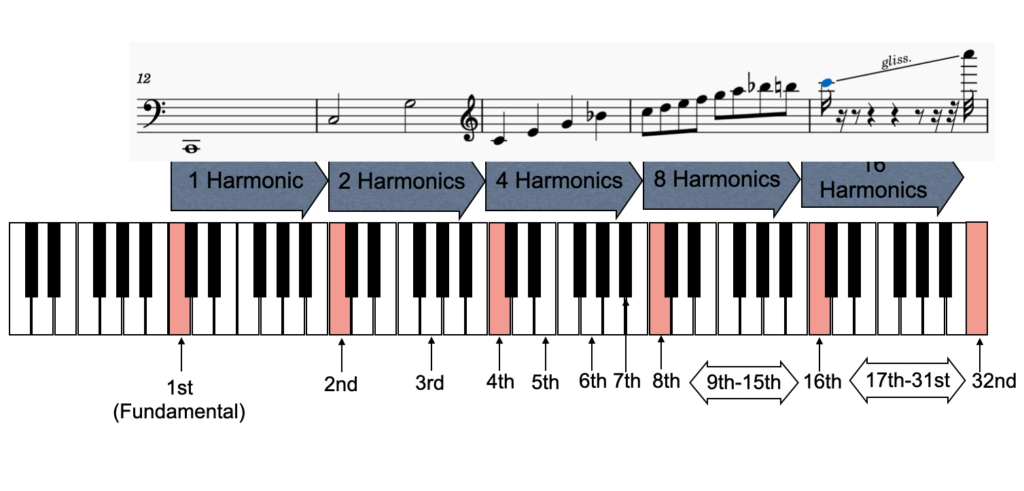
Notes of the harmonic series...
Harmonics are multiples of the lowest frequency. The most common form, are straight multiples of that frequency…. so double, triple, quadruple, etc..
So a note which had a fundamental frequency of 100Hz would have harmonics at 200Hz, 300Hz, 400Hz, 500Hz, etc.
When you place these on a piano keyboard, you can see that 1, 2, 4, 8, 16 & 32 are all the same note (highlighted red) at 1, 2, 3, 4 & 5 octaves higher…. and in each subsequent octave, there are twice as many harmonics.
Musically, the notes start with big intervals which get smaller and smaller… until from 17 upwards, the gaps are less than a single semitone and too small to fit the keyboards notes!
Bell Harmonics
Bells have very specific harmonics that are based on two separate elements.
In the diagram, we show the notes which would match the harmonics for a bells in C. All but one of the important ones are either C’s or G’s.

The Strike Note (Pink)
- It is produced when the clapper hits the bell.
- It is the percussive note we hear as the pitch of the bell.
- It will be a very loud, transient thing… and is gone in a fraction of a second.
The Hum Note (Green)
- This follows on after the strike note.
- It’s the sound which will linger for many seconds and gradually fade away to nothing.
- It includes a lower pitched note with its own set of harmonics… but is closely related to the strike note.
The 5 lowest harmonics are the loudest and most important ones. The founder will tune these by cutting away the inside of the bell with a giant lathe. Different places from the rim and moving up the inner waist, will tune the different harmonics.
Often the loudest harmonic, the prime will be key in working out the bell’s pitch. It is unusual as for most instruments it is the lowest which is loudest… however, although the hum is very much quieter initially, it will become much more significant in the later stages of decay. In practice however, our ear will do subtraction and work out that the Hum is the root, even when it is no the strongest harmonic, simply because it will be the common factor for all harmonics except the Tierce.
This means the Tierce is the odd one out, as it is tuned to a note which is not part of the standard harmonic series.… We would need to get all the way to the 19th harmonic to find a mathematical relative. It is however a key element of all bells and provides the characteristic sound we associate with bells.
There are lots more very quiet harmonics too, but in real terms they only add the tiniest of details to the sound and would not be individually noticeable to anyone without measurement and analysis tools.
